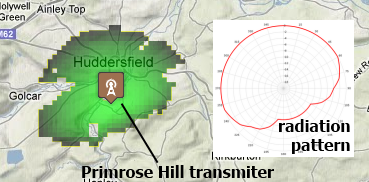New and improved Freeview radiation patterns

What are radiation patterns?
All ground-based broadcast transmitter – be it for a Freeview, DAB, AM/FM radio or mobile phones – can and do broadcast their output at different levels in different directions.
The diagrams here on UK Free TV show all the known patterns. In theory each transmitter can have a different pattern for each transmission frequency.
This diagram shows how the Primrose Hill Freeview transmitter's coverage map and the radiation pattern for it.

Why did you say "known patterns"?
Because, and I quote
- disclosure of the antenna radiation patterns into the public domain could lead to these being available to foreign administrations, which would substantially weaken HM Government's negotiating position with respect to international frequency clearance;
- a weaker negotiating position for HM Government may lead to additional cost for the broadcasters (where antenna systems have to be re-built as a result of international coordination) and lower coverage for viewers (where antenna systems have to be restricted in order to protect foreign transmissions); and
- the BBC is required to provide coverage of its services on digital terrestrial television to a certain proportion of the population by the completion of switchover and a failure or suboptimal result from international co-ordination may harm the BBC's ability to meet this obligation.
The number of sites that we have data is limited to the data released by the BBC in 2009 – see Update on transmitter radiation patterns (BBC FOI request) – plus the new data from Ofcom.
What is the new data?
With help from Dave Lindsay, I contacted Ofcom to ask them to release the data related to the upcoming UK Digital Terrestrial Television: International Coordination Agreements
Do the new patterns match the output?
"While you are already aware of this, I would like to emphasise that the powers and antenna templates in these files represent the upper limit of the UK’s internationally agreed rights for specific frequency assignments, and the actual antenna patterns and/or powers used by the broadcasters are often more restricted. Additionally, not all of the assignments which have been co-ordinated are currently in use." - Ofcom
New SVG format
UK Free TV was using "HTML5 canvas" to draw the radiation patterns. However the site now uses the SVG format for the graphics. This has the several advantages, in particular that it is now easy to embed more than one diagram in a page where necessary.
Some examples of the new data
Where the diagrams show (CCN) this is the new "Co-ordination combined nominal template derived from International co-ordination technical agreements" data. A pattern with a "F" prefix is for a frequency not currently used at that mast for a live TV service (F570 is 570MHz also known as UHF C33).

What next?
The site's coverage maps will be regenerated soon to include all this new data.
9:42 PM
Lionel Campuzano:
There's a reply to your earlier post here Pick +1 | free and easy
| link to this comment |
10:40 AM
Is it worth changing my Yagi array for a similar sized log periodic? Here in Eastern Oswestry, signal varies from minute too minute, especially when traffic is heavy on the adjacent A5/483,
Some days/nights it becomes un usable, despite, masthead amp and dual screened cable.
I have faffed about for hours, but what is really reasonable one minute can turn egg shaped within a 3 or 4 minute period.
Trying to record to hard disc is just a repeat of the same garbage reproduced later!
| link to this comment |
12:28 PM
Henry Porcher: Size for size, log periodic antennas have less gain than Yagi antennas. Your situation
seems particularly difficult and really only a local installer may have a solution or a way to alleviate
the problem. The only off-the-wall suggestion I can make is to get the highest gain and tightest
receive aperture Yagi and try and find a reflection from a not too distant building not looking over the
main road or directly from your second choice transmitter at your postcode if that avoids the road.
Using satellite reception should completely solve the problem of course.
| link to this comment |
1:30 PM
Henry Porcher:
A full postcode so predicted reception can be checked would be a good idea. You need to check you haven't already got too strong a signal if you are not going to use a professional installer that has all the correct equipment for measuring signal strength and ideally a spectrum analyser in case there's odd things going on. Your location might be one where there'd need to be some compromise as some multiplexes may not be receivable as well as others.
You haven't given any indication of which transmitter you use, there's a few on Planned Engineering which might be affecting you.
| link to this comment |
